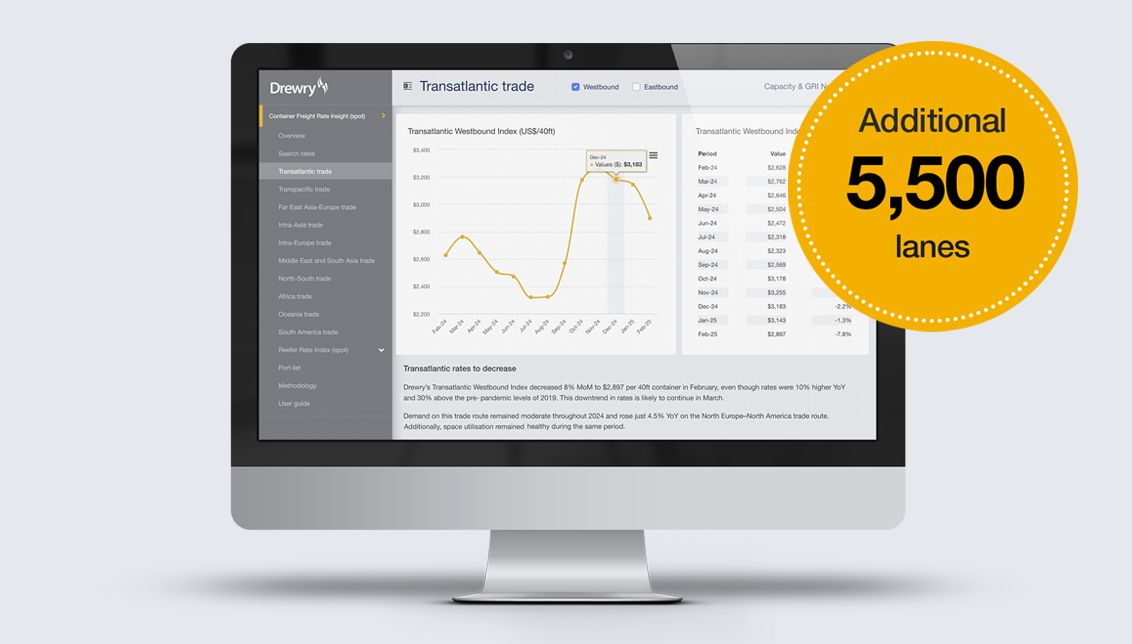Browse Services by Sector
Container ShippingContainer Equipment Assets
Ports and Terminals
Dry Bulk Shipping
Tanker Shipping
Gas Shipping
Specialised Shipping
Airfreight Transport
Logistics Management
Ship Operations and Management
Other popular areas
Browse subscriptions by Sector
Container ShippingPorts and Terminals
Dry Bulk Shipping
LPG Shipping
LNG Shipping
Crude Tanker Shipping
Product Tanker Shipping
Financial Advisory
Valuations
Drewry Financial Research Services Ltd is authorised by the UK Financial Conduct Authority (FCA).
Maritime Research
Container Shipping Financial Health Check 2025
February 2025

2025 a year of rising debt and high volatility
In 2023, oversupply and weak demand drove freight rates down, but the Red Sea disruptions late in the year reversed the trend. The 2024 Suez Canal closure forced longer voyages via the Cape of Good Hope, rebalancing supply and demand with Asian port congestion, worsened by bad weather and front-loading, which spread to Europe, further supporting rates. Demand rebounded due to inventory replenishment, lower interest rates and pre-emptive shipping ahead of potential US tariffs.
Our latest ’Financial Health Check’ of 12 major carriers (based on their published 9M24 financials) shows improved stability, with Z-scores rising to the safe zone. However, the industry faces a key question—can stability hold, or are we headed for a correction? This report examines the forces shaping container shipping and risk profiles of the leading carriers.
Key findings within this year’s report include:
Supply chain disruptions led to a sharp upward revision in earnings projections for 2024, with industry profits far exceeding initial estimates. However, 2025 is expected to bring in softer freight rates and slower volume growth as congestion eases and economic uncertainties mount, thereby squeezing margins.
Financial health improved, with ZIM leading in capital efficiency, far exceeding its cost of capital. Industry-wide returns strengthened, and overall financial stability improved. Debt levels rose as carriers expanded their fleets.
With tightening environmental regulations (scope of EU ETS expanding to 100% coverage by 2026 and FuelEU Maritime (2025) promoting cleaner fuels) carriers are adopting mixed green strategies, with some investing in methanol fuels while others continue to favour LNG.
In 2024, container shipping companies’ vertical integration slowed but remained active with 14 deals, focusing on last-mile logistics as opposed to core container shipping capabilities.
The Drewry Container Equity Index rose 17.6% in 2024 but dropped 8% YTD (ending 30 January 2025), reflecting investor caution. The sentiment weakened as investors anticipate an earlier-than-expected rate decline if Red Sea routes reopen.
Key challenges include oversupply risks, shifting alliances and regulatory costs. If Red Sea disruptions ease, extra capacity may lower rates while US tariffs could impact trade flows in late 2025-26. Despite strong profits, debt is rising, signalling a cautious outlook.
More Information
Contents:
- Executive summary
- Industry Update
- Company Update
Companies Featured:
- AP Moller Maersk
- Hapag-Lloyd
- Samudera Shipping Line Ltd
- SITC International Holdings
- Wan Hai Lines Ltd
- Orient Overseas (International) Ltd
- Yang Ming Marine Transport Corp
- ZIM Integrated Shipping Services Ltd
- Evergreen Marine Corp Taiwan Ltd
- COSCO Shipping Holdings Co Ltd
- HMM Co Ltd
- Ocean Network Express Pvt Ltd
News
© Copyright 2025 | Drewry Shipping Consultants Limited. All Rights Reserved. Website Terms of Use | Privacy Policy


